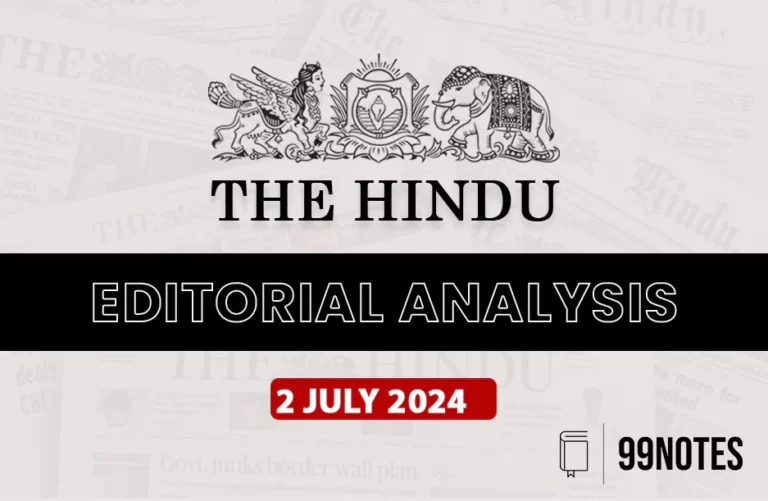20 January 2024 : The Hindu Editorial Notes PDF
The Hindu Editorial
20-January-2024
1. Gearing up for change
| Topic: GS1 – Geography – Monsoon This topic is relevant for both Prelims and Mains in the context of understanding monsoon, its regional variability and importance of meteorological analysis for guiding regional planning, enhancing climate resilience, and allocating resources effectively |
| Context: |
|
Celebrating 150 Years of the IMD
- The India Meteorological Department (IMD) recently observed its 150th year.
- Originating in colonial times, it initially focused on unraveling the mysteries of the southwest monsoon to aid British administrators in revenue planning.
IMD’s Comprehensive Analyses
- Over time, the IMD has evolved to analyze a broad spectrum of climate and weather phenomena.
- From cyclones to fog, the department now provides comprehensive forecasts crucial for various sectors.
CEEW Study on Monsoon Trends (1982-2022)
- The Council on Energy, Environment, and Water (CEEW) conducted a study on monsoon trends at the tehsil level from 1982 to 2022.
- Findings reveal an increase in monsoon rainfall in 55% of India’s tehsils, with 11% experiencing a decrease.
Regional Impacts and Changing Patterns
- Critical sowing months, June and July, saw reduced rainfall in specific tehsils, notably in the Indo-Gangetic plains, northeastern India, and the Indian Himalayan region.
- Traditionally dry regions, including parts of Rajasthan, Gujarat, central Maharashtra, and Tamil Nadu, are witnessing increased rainfall.
- The northeast monsoon has shown a significant rise in certain regions over the past decade.
Implications for Climate Resilience
- Nearly 76% of India’s annual rainfall is attributed to the southwest monsoon.
- Ongoing research aims to distinguish the influence of natural variability from that of global warming.
- The importance of meteorological analyses lies in guiding regional planning, enhancing climate resilience, and allocating resources effectively.
Conclusion:
- The study underscores the importance of meteorological analyses for guiding regional planning, enhancing climate resilience, and allocating resources effectively.
- The call to prioritize localized forecasts over national ones signals a forward-thinking approach for the government in addressing evolving climate scenarios.
| About India Meteorological Department (IMD) |
|
| PYQ: Discuss the meaning of colour-coded weather warnings for cyclone prone areas given by India Meteorological Department. (150 words/10m) (UPSC CSE (M) GS-1 2022) |
| Practice Question: Evaluate the implications of the Council on Energy, Environment, and Water (CEEW) study on India’s monsoon trends for climate resilience and governance, particularly in the context of the increasing vulnerability to dry spells and intense wet periods. (250 words/15m) |
2. The problem with India’s science management
| Topic: GS3 – Science & Technology – Achievements of Indians in S&T This topic is not much relevant in the context of Prelims but more for Mains in the context of understanding challenges faced by India in research and development and measures to address these challenges. |
| Context: |
|
Overview of India’s Science Establishment
- Importance of Scientific Advances: Sustained economic progress tied to national ambitions relies on scientific advances translated into deployable technologies.
- Government Initiatives: The government is revamping India’s science establishment, introducing the National Research Foundation (NRF) and restructuring the Defence Research and Development Organisation (DRDO).
- Need for Assessment: The article emphasizes the need for a candid evaluation of the current administrative capacity to optimize Indian science’s efficiency and resilience.
Challenges in Research and Development
- Low Expenditure: India’s research and development expenditure is approximately 0.7% of GDP, significantly lower than the United States (3.5%) and China (2.4%).
- Allocation of Resources: With limited funding, it becomes crucial to allocate resources wisely and focus on high-impact projects.
- Issues in Space and Nuclear Energy: The article points out shortcomings in India’s space program, ranking eighth globally in launch numbers, and delays in embracing small modular reactors in nuclear energy.
- Concerns in Critical Technologies: India lags in critical science and technology domains such as genomics, robotics, and artificial intelligence.
Administrative Challenges in Indian Science
- Public Sector Dominance: India’s science is predominantly governed by the public sector, leading to generic bureaucratic issues such as delays in funding approvals.
- Role of Scientists: Senior scientists play a significant role in administration, leading to challenges in decision-making, long-term funding commitments, and prioritization.
- Skill Set Mismatch: The article argues that good scientists may not inherently possess the administrative skills required for effective science management.
- Conflicts of Interest: The centrality of scientists in administration leads to potential conflicts of interest, compromising the integrity of the system.
- Historical Root Causes: The article traces the root causes of the present administrative challenges back to the concentration of high-end equipment in specific institutions, creating gatekeepers who control appointments and influence.
Proposed Solutions
- Separation of Roles: The article suggests a separation of roles between scientists and administrators, akin to established practices in robust science establishments globally.
- American Model: Drawing from the U.S. system, the passage proposes an American middle-way arrangement where scientists are selected and trained in an all-India pool for science administration.
- Training for Administrators: It advocates for the creation of an all-India service pool for science administration, similar to an administrative central service, to ensure proper training and specialization.
Conclusion:
- The article concludes by highlighting the necessity of teaching and practicing administration separately from scientific subjects, emphasizing the importance of addressing core concerns for India’s science establishment to meet economic and strategic aspirations.
| PYQ: Scientific research in Indian universities is declining, because a career in science is not as attractive as our business operations, engineering or administration, and the universities are becoming consumer oriented. Critically comment. (200 words/12.5m) (UPSC CSE (M) GS-3 2014) |
| Practice Question: Examine the challenges faced by India in research and development, particularly in terms of low expenditure and concerns in space and nuclear energy. Propose strategic measures to address these challenges and enhance India’s position in critical technologies. (250 words/15m) |
For Enquiry

20 January 2024 : The Hindu Editorial Notes PDF

20 Jan 2024 : Indian Express

20 Jan 2024 : Daily Current Affairs

20 Jan 2024 : PIB

19 January 2024 : The Hindu Editorial Notes PDF

19 Jan 2024 : Daily Answer Writing

19 Jan 2024 : Daily Current Affairs

19 Jan 2024 : Indian Express

19 Jan 2024 : PIB

18 Jan 2024 : Daily Quiz
Jan 2024 The Hindu 20 January 2024 : The Hindu Editorial Notes PDF The Hindu Editorial
19-January-2024
1. Smaller citizens
Topic: GS2 – Social Justice- Education
This…
Indian Express 20 Jan 2024 : Indian Express Indian Express
20- January-2023
1. A green blueprint
Topic: GS3 – Environment – Environmental…
Daily Current Affairs 20 Jan 2024 : Daily Current Affairs Daily Current Affairs
20-January-2024
1. Scientists Uncover Largest Deep Coral Reef off US Atlantic…
Jan 2024 PIB 20 Jan 2024 : PIB PRESS INFORMATION BUREAU
20-January -2024
1. PM inaugurates opening ceremony of the Khelo India Youth…
Jan 2024 The Hindu 19 January 2024 : The Hindu Editorial Notes PDF The Hindu Editorial
19-January-2024
1. Smaller citizens
Topic: GS2 – Social Justice- Education
This…
mains answer writing 19 Jan 2024 : Daily Answer Writing Mains Answer Writing
19-January-2024
Q1) “The changes in labour market and employment pattern in recent…
Daily Current Affairs 19 Jan 2024 : Daily Current Affairs Daily Current Affairs
19-January-2024
1. Iran-Pakistan Crisis in Balochistan: Background, and Pakistan’s…
Indian Express 19 Jan 2024 : Indian Express Indian Express
19- January-2023
1. Compete to thrive
Topic: GS2 – Polity – Statutory Bodies
This…
Jan 2024 PIB 19 Jan 2024 : PIB PRESS INFORMATION BUREAU
19-January -2024
1. Ministry of Textiles approves 11 R&D projects valuing…
Daily Quiz 18 Jan 2024 : Daily Quiz 18 Jan 2024 : Daily Quiz…





